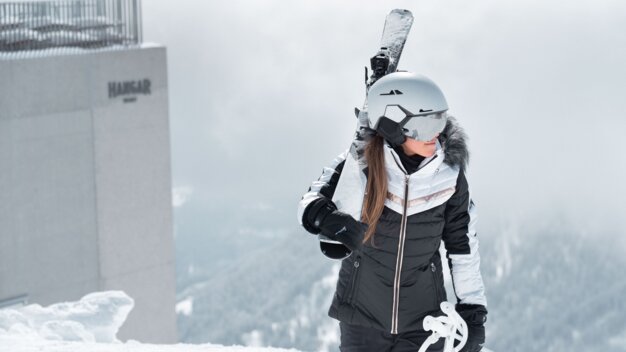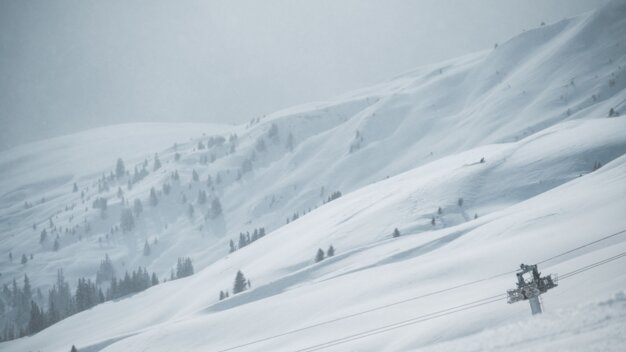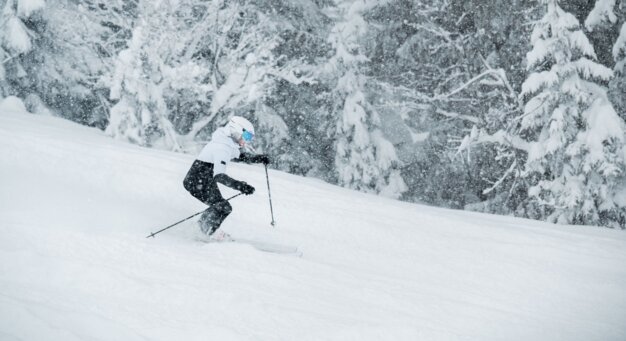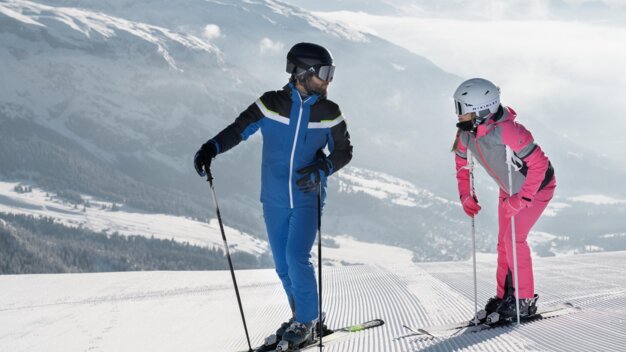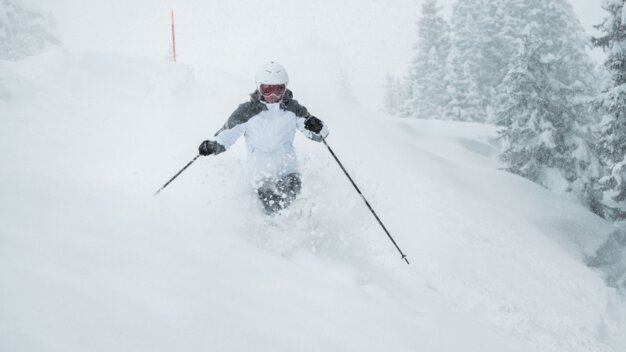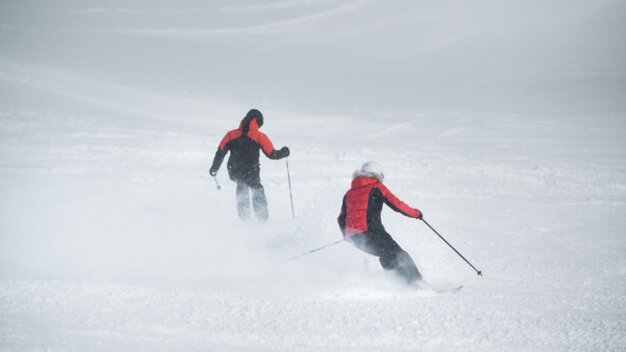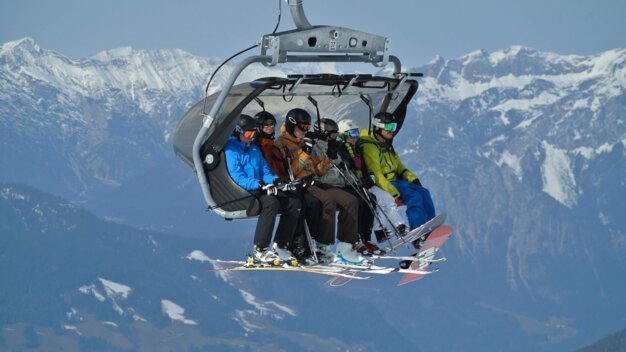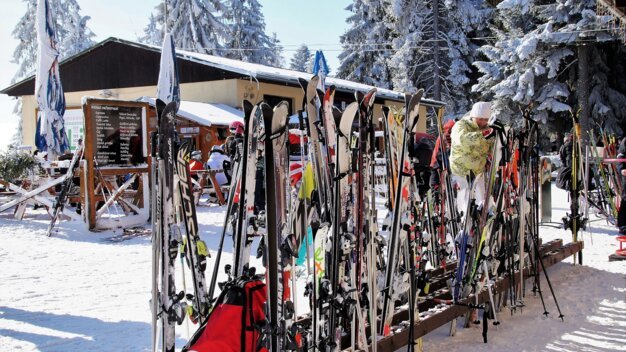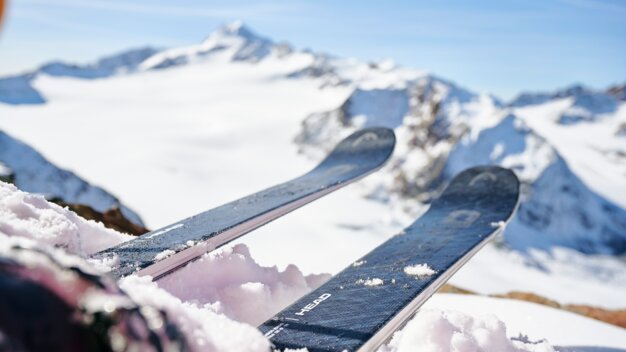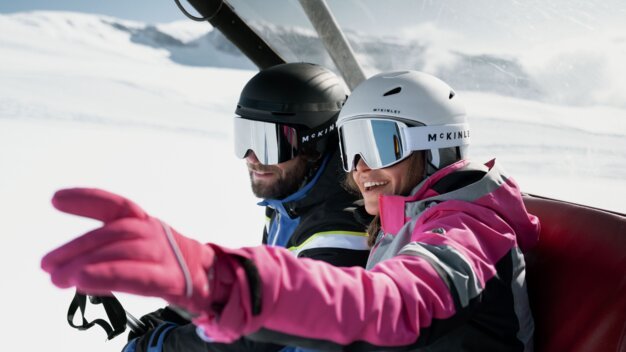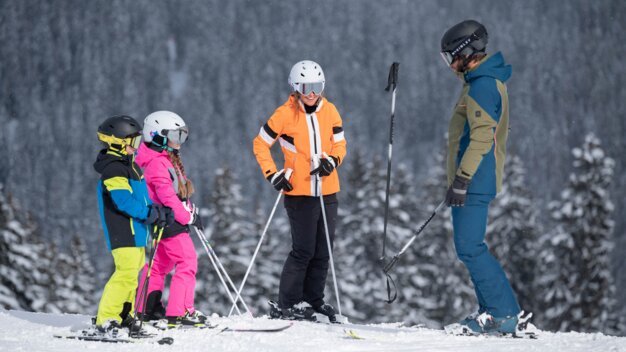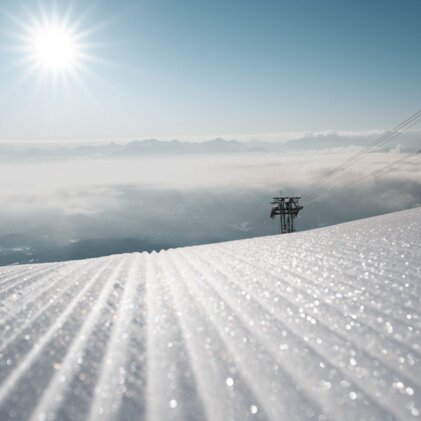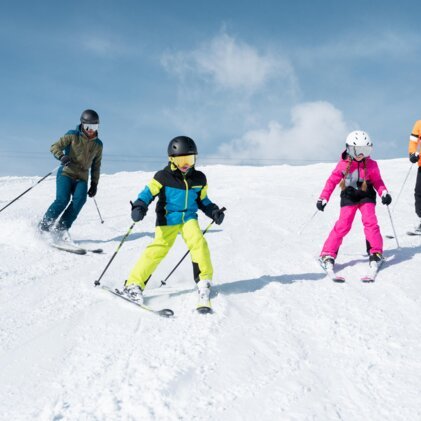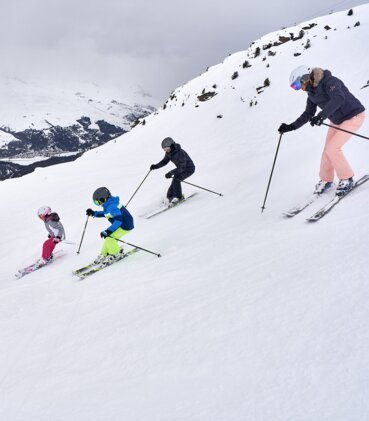
Did you know that most accidents on the slopes happen due to inattention and because people don’t know how to correctly assess their own abilities? This also means that the majority of accidents while skiing and snowboarding only involve one skier and could easily be prevented. Collisions, on the other hand, are rather rare.
So if you ask yourself how you can avoid skiing injuries and accidents, the best answer is: by skiing and snowboarding responsibly! But how do you do that, and what kind of behaviour contributes to a safer experience on the slopes? Our winter sports experts at INTERSPORT Rent have the answers for you!
How do I ski and snowboard safely?
Several factors have a positive impact on safety when skiing or snowboarding. First and foremost: the right equipment – and there is definitely more to that than just wearing a helmet. You can learn all about equipment and safety below.
Physical fitness & skill level
Besides the right equipment, your physical fitness also plays a key role: How in shape are you? Are you tired or well-rested on a certain day? Do you work out regularly, or did you just start training for the ski season? Have you already mastered the technique, or should you take lessons first?
We recommend: Choose the resort you want to ski in based on your personal skiing ability and fitness level!
Ready for your ski day? Great! But before you head out, be sure to check the weather forecast – and pay special attention to the avalanche warning level.
Find out how to read and interpret an avalanche forecast correctly.
Before you go skiing and snowboarding: Do a warm-up!
When you finally arrive in the mountains, you would like to hit the slopes right away – that’s understandable! However, we recommend you warm up before you head out in the morning and after long periods of inactivity.
You could do the following exercises, for instance:
- Swing your arms back and forth several times and bend your knees each time you gather momentum.
- Move your elbows and wrists (e. g. by rotating them).
- Stretch your calves and thighs.
- Once you’ve put on your skis, alternately shift your weight from left to right.
Tip: Start with an easy downhill run and then work your way up in terms of speed and difficulty. You don’t need to tackle the resort’s black runs right away!
While skiing: Take breaks!
If you want to ski responsibly, be sure to take breaks at regular intervals – even before you get tired. Because fatigue and overexertion often lead to injuries and accidents. You're thinking of a stop for a bite to eat and a few beers? Please opt for a non-alcoholic beverage instead!
Alcohol is definitely a no-no when skiing. Firstly, because it alters risk perception and risk-taking behaviour. Secondly, because it slows down reaction time. And thirdly, because the effect of alcohol is much stronger at higher altitudes. All this significantly increases the likelihood of accidents.
FIS rules of conduct
for skiers and snowboarders
For more safety on the slopes, the International Ski Federation (FIS) has issued a series of slope rules. In essence, the point is to be more considerate of other winter sports enthusiasts and to always adapt one's skiing style to the prevailing conditions – with the primary goal of avoiding accidents.
The FIS rules of conduct must be observed by everyone using the slopes. Otherwise, accidents can have civil and legal consequences for those involved. The FIS rules can usually be found at the lift stations at the ski resorts, but if you want to read them now, you’re more than welcome to:
- Respect and consideration for other skiers and snowboarders: All skiers and snowboarders must behave in such a way that they do not harm or endanger others.
- Control of speed and skiing style: All skiers and snowboarders must adapt their speed and manner of skiing to their personal ability, to the terrain, snow and weather conditions as well as to the density of traffic.
- Choice of route: Skiers and snowboarders coming from behind must choose their route in such a way that they do not put skiers and snowboarders in front of them at risk.
- Overtaking: A skier or snowboarder may overtake another skier or snowboarder from above or below, from the right or from the left, provided that they leave enough space for the overtaken skier or snowboarder to make any voluntary or involuntary movement.
- Entering, starting, and moving up the slope: A skier or snowboarder entering a marked run, starting again after stopping or moving upwards on the slopes must look up and down the slopes to ensure that they can do so without putting themselves or others at risk.
- Stopping: Skiers and snowboarders must avoid stopping on the slope in narrow places or where visibility is restricted, unless absolutely necessary. After a fall in such a place, the skier or snowboarder must move and clear the area as quickly as possible.
- Ascending and descending: Skiers or snowboarders ascending or descending on foot must do so using the edge of the slope.
- Respecting the signs and markings: Every skier or snowboarder must respect the signs and slope markings.
- Duty to provide assistance: In the event of an accident, every skier and snowboarder is duty-bound to assist.
- Obligatory identification: In the event of an accident, every skier or snowboarder, whether a witness or involved party, whether responsible or not, must provide personal identification.
In addition to the general rules of conduct, the FIS has also issued a number of environmental rules as well as guidelines for more safety on lifts.
FIS environmental rules
Responsible skiing also includes treating nature with respect. And this already starts with the choice of ski resort – ideally, one that is as sustainable as possible. It continues with the journey to the resort: Preference should be given to environmentally friendly means of transport, carpooling and the use of local ski buses.
On the mountain, avoid skiing off marked slopes, especially in forests and protected areas. That’s the easiest way to contribute to the protection of the local flora and fauna. Also be sure to correctly dispose of any waste – both at the ski resort and at your accommodation.
FIS rules for safety on cable cars and chairlifts
On the one hand, the FIS addresses lift operators who are responsible for a smooth operation. On the other hand, the users of the lifts are asked to comply with the regulations of the operators. In addition, they are expected to assess for themselves whether they meet the physical and technical requirements for safe lift travel.
Is your equipment fit for the slopes?
The FIS rules state: "Skiers and snowboarders are responsible not only for their own behaviour but also for their equipment – and thus the consequences of wearing defective equipment. The same applies to users of newly developed sports equipment." Consequently, it is advisable to have your winter sports equipment checked regularly (at least once a year), serviced and, if necessary, repaired and adjusted by a specialist.
Good to know: At INTERSPORT Rent, you only get equipment that is as good as new and in tip-top condition. The RENTertainers will look after you personally and make sure your gear is adjusted correctly.
DIY ski tuning: Find out more about how to wax your skis and sharpen the edges at home!
Even when buying new ski or snowboard equipment, you should always rely on professional support. Women, for instance, injure their knees more frequently than men when skiing. So, they should choose lighter skis that are easier to manoeuver – the same goes for beginners. Are you planning to get new skis? Then go ahead and read our article “How to find the perfect pair of carving skis”!
Helmets and other protective gear
If you value safety while skiing and snowboarding, you need to wear a helmet. When buying one, you should look for one that meets the EN 1077 standard. We also recommend that you find a pair of ski goggles that are compatible with your helmet.
Did you know? In some countries, wearing a helmet is compulsory – in Austria, for instance, they’re mandatory for children and youths up to the age of 15.
Wrist guards are also part of the protective gear. Snowboarders in particular wear these protectors to prevent wrist fractures. Flexible protectors are preferable to those with hard shells in this case.
Last but not least, you can avoid injuries while skiing and snowboarding with the help of back protectors: They protect the spine from sudden direct impact but not from the frequently occurring sprains. These kinds of protectors are mostly worn by freeride and freestyle skiers and snowboarders, but we also recommend wearing them when you’re out and about on the slopes. To make sure they come in the required quality, you can check whether they fulfil the EN 1621-2 standard.
Responsible skiing and snowboarding with children
You're probably familiar with this situation: Your little ones are starting to get better at skiing and before you realise, they become uncontrollable little speedsters. What rules can parents follow when skiing and snowboarding with children to avoid unpleasant situations? With the following tips, you can make sure your child stays safe on the slopes:
- Regularly check whether the equipment is in perfect condition and correctly adjusted to your child. Our tip: Rent your kids’ gear at INTERSPORT Rent, and our RENTertainer will make sure of that.
- Have your children take lessons to learn how to ski or snowboard. The instructors will teach them how to prepare for the dangers on the slopes in a playful manner.
- Practice on easy, wide, and less frequented slopes. This way, your kids can focus on the essentials and have more fun while learning.
- Be a good role model: Observe the FIS rules, wear a helmet, and behave responsibly on the slopes! Children also learn by imitation, after all.
- In case you lose each other at the ski resort: Give your child your contact details or the address of your accommodation!
- Do not use a children's ski harness! This negatively affects the child's natural learning behaviour.
- Important: Children smaller than 1.25 metres must be accompanied by an adult when using a chairlift – with the exception of special child-safe lifts, which can be found at some family-friendly ski resorts.
- Make your kids wear a helmet! Children who do not wear a helmet frequently sustain head injuries in skiing accidents. Also, find out if helmets are compulsory for children at the resort or region you ski in.
Speaking of helmets: Find out “How to choose the perfect size for children's ski helmets”
INTERSPORT Rent tip
What to do in case of an emergency:
- Secure the site of the accident.
- Administer first aid.
- Keep the injured person warm.
- Contact the emergency services or the staff at the nearest lift station.
Emergency numbers:
- International: 112
- Austria: 140
- Switzerland: 1414
- Italy: 118
Remember: According to the FIS rules, you are obligated to help in case of an accident!
Related articles
You may also be interested in:
